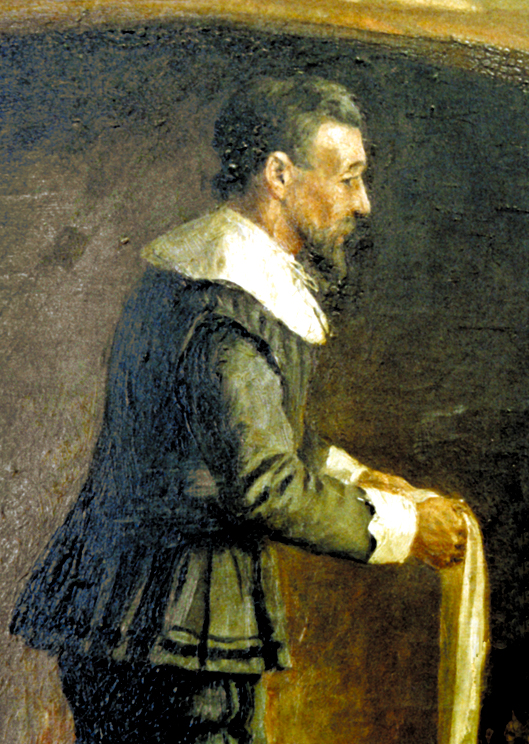Fashionable stockings
Hand knitting in England expanded as an industry in Tudor times (1485-1603). Knitted caps and stockings were highly fashionable.

William Lee
From the time of Henry VIII, fine knitted silk stockings imported from Spain were part of court fashion. Previously, a piece of cloth was cut to the shape of a leg and the edges sewn together to create a stocking. By the time of Elizabeth I, knowledge of how to hand knit stockings had spread around England and documents refer to the industry in places as far apart as London, Kingston (Surrey), and Richmond (Yorkshire).
The first knitting frame
The increasing popularity of knitted stockings at court and beyond created opportunities for entrepreneurs to make money. In 1589 William Lee of Calverton, Nottinghamshire, successfully converted the actions of hand knitting with two needles into a mechanised process. This was the first knitting frame. Like the hand knitting process, the knitting frame produced a shaped piece of fabric that was then sewn together to create a garment.
Failure to get a patent
Lee wanted to protect his invention by obtaining a patent from Queen Elizabeth. Lord Hunsdon, a courtier, promoted the case for the knitting frame to the Queen, but without success. The woollen fabric produced by the early frame was considered to be too coarse compared with fine silk stockings. The frame was also seen as a threat to the hand knitting industry which might lead to many people losing work. Lee responded to the Queen's comments and improved the frame by increasing the number of needles per inch from eight to twenty. This knitted a finer fabric. Unfortunately for Lee, his supporter, Lord Hunsdon, died in 1596, dashing any hopes of securing a patent for the frame.
French tribulations
Convinced of the value of his machine, Lee crossed the Channel to France where Henry IV promoted religious tolerance and actively encouraged the development of industry. Lee's brother James, nine workmen, and nine frames, accompanied Lee on the journey. From a base in the town of Rouen, Lee began to establish his business. A contract was drawn up with Pierre de Caux to supply frames and train apprentices so that production of garments could commence by 26 March 1610. The business seemed to be progressing well, but unfortunately for Lee, the political scene changed rapidly when Henry IV was assassinated in 1610. In the uncertainty, Lee travelled to Paris and died a broken man around 1614.
London and Nottingham
After Lee's death, James Lee returned from France with eight frames and seven of the workmen. James promptly disposed of the remaining frames in London and returned to Nottinghamshire where Lee's apprentice, Aston, had continued to work on the frame and made a number of improvements. The route of James Lee's return resulted in the establishment of two knitting centres, one based in London with the older frames, and one in Nottingham using the newer frames.